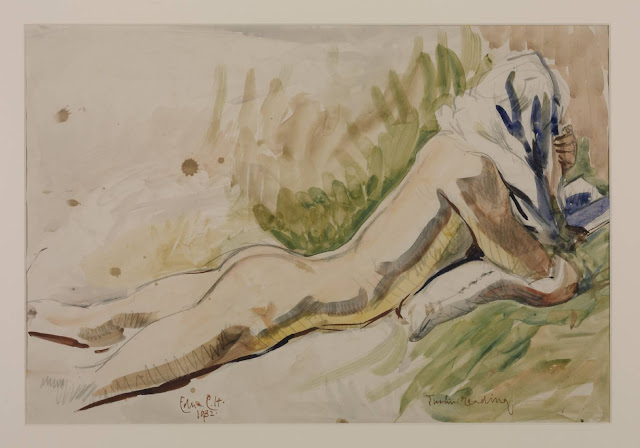 |
| Jacopo de' Barbari Two Old Men Reading ca. 1509-1515 engraving Rijksmuseum. Amsterdam |
 |
| Lady Clementina Hawarden Clementina Maude Reading ca. 1862-63 albumen print Victoria & Albert Museum |
 |
| follower of Baccio Baldini or follower of Maso Finiguerra King Minos in a Landscape of Books (from The Florentine Picture Chronicle) ca. 1470-75 drawing British Museum |
 |
| Umberto Boccioni Young Woman Reading (Ines) 1909-1910 drawing Metropolitan Museum of Art, New York |
 |
| Parmigianino Youth with Book ca. 1518-40 drawing Victoria & Albert Museum |
 |
| Alessandro Allori Kneeling Young Woman with Open Book (study for figure of Mary - Christ in the House of Martha and Mary) ca. 1580 drawing British Museum |
 |
| Hendrik Jacobus Scholten Sunday Morning ca. 1865-68 oil on panel Rijksmuseum, Amsterdam |
 |
| Anders Zorn The Artist's Wife Reading 1889 pastel Nationalmuseum, Stockholm |
 |
| Albert Bartholomé The Artist's Wife Reading 1883 pastel Metropolitan Museum of Art, New York |
from Sempre Susan, a memoir by Sigrid Nunez (Atlas & Co, 2011) –
Susan was one of those literary Americans for whom European writers would always be superior to native ones . . .
The gaps in my knowledge didn't really surprise her. She had a low opinion of American education and of American culture in general, and she took it for granted that I could learn more in a year at 340 [Sontag's apartment at 340 Riverside Drive in Manhattan] than I had in six years at an American university.
But she had no more use for most contemporary American fiction (which, as she lamented, usually fell into either of two superficial categories: passé suburban realism or "Bloomingdale's nihilism") than she did for most contemporary American film. . . . What thrilled her instead was the work of certain Europeans, for example Italo Calvino, Bohumil Hrabal, Peter Handke, Stanislaw Lem. They, along with Latin American writers such as Jorge Luis Borges and Julio Cortázar, were creating far more daring and original work than her less ambitious fellow Americans.
Also, in public appearances, she often came across as not merely humorless but ill-tempered. Especially during question-and-answer periods, she was inexplicably quick to anger – I'm surrounded by idiots was the message her eyes flashed – quick to insult. (The problem, according to her, was the usual one: compared to European audiences, Americans were vulgar and uninformed and their questions were usually trivial.)
With Susan, on the other hand, I felt as if I were being given permission to devote myself to these two vocations – reading and writing – that were so often difficult to justify. And it was clear that, no matter how hard or frustrating or daunting it was – no matter how much like a long punishment writing a book could be – she would not have chosen any other way; she would not have wanted any other life than the life she had.
"A writer's standards can't ever possibly be too high."
"Never worry about being obsessive. I like obsessive people. Obsessive people make great art."
She liked outsiders, too. It pleased her to see herself as an outsider.
And just because you were born an American didn't mean you couldn't cultivate a European mind.
To read a whole shelf of books to research one twenty-page essay, to spend months writing and rewriting, going through one entire ream of typing paper before those twenty pages could be called done – for the serious writer, this was, of course, normal. And, of course, you didn't do it to feel good about yourself. ("My first feeling about everything I write is that it's shit.") You didn't do it for your own enjoyment (unlike reading), or for catharsis, or to express yourself, or to please some particular audience. You did it for literature, she said. And there was nothing wrong with never being satisfied with what you did. (Indeed, if you weren't regularly tormented by self-doubt, your work probably was shit.)
"The question you have to ask yourself is whether what you're writing is necessary." I didn't know about this. Necessary? That way, I thought, lies writer's block.
She was so New York. And in her boosterism, in her energy and ambition, in her can-do, beat-whatever-the-odds spirit, in her childlike nature – and in her belief in her exceptionalism and in the power of her own will, in self-creation, and in the possibility of being reborn, the possibility of endless new chances, and of having it all – she was also the most American person I knew.
"Well, here we are," she says huddling against Joseph [Brodsky, the exiled Russian poet and Sontag's lover]. "Not even middle-aged, and struck by the top two killer diseases."
The talk turned to Hope Against Hope, Nadezhda Mandelstam's memoir of life under Stalin, in which she compares that hell to the pain and suffering of normal family life. "What wouldn't we have given for such ordinary heartbreaks!"
Joseph shrugs, unmoved. "Trust me, she had plenty of those, too." And, after a broody pause: "You know, in the end, none of it matters, what happens to you in life. Not suffering. Not happiness or unhappiness. Not illness. Not prison. Nothing."
Now, that's European.
 |
| Simone Cantarini Sibyl Reading ca. 1630-35 oil on canvas Banca Popolare dell' Adriatico, Pesaro |
 |
| Albert Engström Portrait of the Artist's Father Reading a Newspaper 1892 oil on canvas, mounted on panel Nationalmuseum, Stockholm |
 |
| Sydney Prior Hall Gladstone Reading 1890s gouache (grisaille) National Portrait Gallery, London |
 |
| Lady Edna Clarke Hall Justin Reading 1932 watercolor Tate Gallery |
 |
| Rembrandt Scholar Seated at Desk 1634 oil on canvas Národní Galerie, Prague |